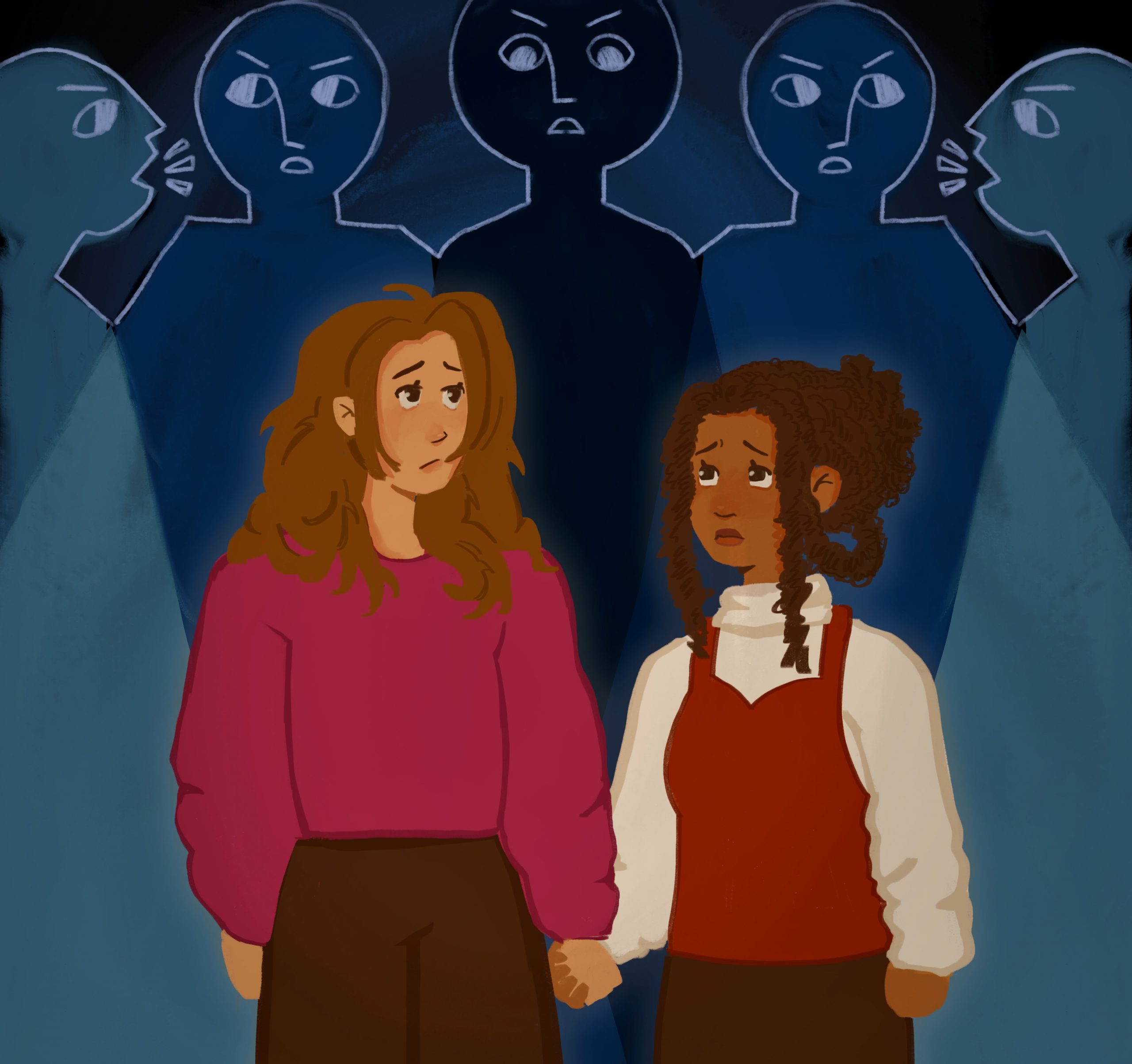Graphic by Maya Balakrishnan/OutWrite
The entertainment industry profits off the sexualization of women. Whether typecast as a complacent suburban housewife or a strong crime-fighting machine, women in media are reduced to their sexual attributes, especially lesbians and other queer people.
This phenomenon of sexualizing lesbian and queer relationships in particular is not new in the industry. Though there are tremendous benefits to the representation of queer relationships in the media, this recurrent pattern appears in many films. Two examples of movies that oversexualize women in a lesbian relationship are “Blue is the Warmest Color” and “Below Her Mouth.” Though both movies take great care to detail the sexual aspects of lesbian relationships, they lack the mental and emotional components.
Queer people who watch these films may feel uncomfortable, as the relationships move extremely quickly with very little communication or dialogue between characters before extremely graphic sexual scenes. The on-screen sex feels particularly unrealistic, as if the lesbian sex scenes are written and shot for a straight male audience.
With the oversexualization of queer relationships, there is a fine line between well-intended inclusion of LGBTQIA+ representation and the exploitation of the queer narrative for profit. Perfect examples of both ends of the spectrum are found in two very popular (teenage audience) shows: “Riverdale” and “Sex Education.”
“Riverdale,” though initially progressive and well-meaning in its depiction of queer characters, took a disastrous turn in its final season when they introduced a “quad” polyamorous relationship between the four main characters: Archie Andrews (KJ Apa), Veronica Lodge (Camila Mendes), Jughead Jones (Cole Sprouse) and Betty Cooper (Lili Reinhart). Though the foursome was a part of the original “Archie” comics (which the show was based on), many fans felt uncomfortable with the inclusion of sexual scenes between Betty and Veronica given that they had never had a sexual relationship before the finale.
Betty and Veronica had never before shown indications of attraction to members of the same sex; however, many scenes in the final season show a sexual relationship between the girls, who were presumed to be best friends. Though they had flirted in the past, it had always been for male attention. Contriving an unconvincing lesbian dynamic instills a false perception of female relationships in viewers. In the case of “Riverdale,” Betty and Veronica’s polyamorous relationship is held together by their male partners, implying that the male gaze is permitted and even encouraged in the actions of queer relationships.
In contrast, “Sex Education” includes many facets of queerness, including lesbian, bisexual, trans and gay relationships, without oversexualizing characters for profit. This encourages on-screen queer representation without feeding into problematic and demeaning stereotypes. Unlike “Riverdale”’s portrayal of queer characters, the show develops its queer couples very similarly to how they develop heteronormative relationships. In most media, queer relationships are depicted as sexual, passionate, or toxic. “Sex Education,” on the other hand, brilliantly spotlights the mundanity and normalcy of a queer partnership.
The progressive new season of the show includes the rarely-seen dynamic of two trans characters in a relationship. Abbi (Anthony Lexa) and Roman (Felix Mufti) are trans characters on screen played by actual trans actors. In the show, they are a couple dealing with relationship struggles and successes involving sex, commitment, and longevity. Instead of the show portraying them as “a trans couple,” they are simply two teenagers who happen to be trans and in a relationship.
Though it is important to address the queer aspects of these relationships, they do not need to be the focus of every interaction. “Sex Education” allows the viewer to witness two young people coming to terms with their sexualities with each other, instead of the traditional “hot lesbian makeout” in other shows.
Queer representation in the media is extremely important as it holds the power of normalization. According to the Centre for Law and Policy Research, “positive portrayals of queer characters and relationships can make members of the community feel more accepted.” The emphasis of this statement resides in the word “positive”. While shows like “Sex Education” portray a wide array of queer people and relationships positively, other media capitalizes on queer inclusion by creating sex appeal.
Such media reduces lesbians to sexual objects for the male gaze. For example, erotic lesbian scenes in media can be directed toward heterosexual cis-gendered men. Using lesbian relationships as clickbait for people outside the queer community translates across real-world interactions. Many lesbians have had the experience of straight cis men harassing or flirting with them with the intention of “turning them straight.” Media representations of lesbians affect the way they are perceived in everyday life, making them feel unsafe to be openly themselves.
Many bisexual and pansexual women also face a similar kind of fetishism through the male desire for a threesome. This assumption that people who are attracted to more than one gender see a threesome as the ideal scenario is highly perpetuated within popular culture and media. Reducing pansexual or bisexual women into the trope of male-gaze attention seekers blatantly disregards accurate representation in favor of a heteronormative storyline.
More attention must be brought to the misogynistic habit of sexualizing women tainting on-screen queer couples. Fortunately, there are many examples of media that have learned to cultivate beautiful, respectful, and inclusive queer relationships — some of which still depict sex — in a way that does not oversexualize the characters. Media companies must look up to examples like “Heartstopper,” “Sex Education,” and “Uncoupled” to understand how to move forward in the future. By giving queer characters complex storylines that do not revolve around sex, they are not only humanized but also validated as real couples.
Credits:
Author: Taylor Kunin-Ur (She/Her)
Artist: Maya Balakrishnan (She/They)
Copy Editors: Maya Parra (She/Her), Bella (She/Her)

